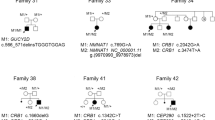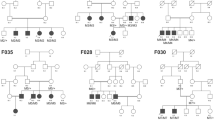Abstract
Leber congenital amaurosis (LCA) is a rare form of early onset vision loss or blindness due to retinal dystrophy. This condition is characterized by early vision loss, nystagmus and severe retinal dysfunction. To date, genetic studies have reported 19 genes to be associated with autosomal recessive LCA, most of which are involved in the retinal morphology and the physiology of the phototransduction pathway. In the current study, a large consanguineous family segregating congenital blindness was ascertained from the Dera Ismail Khan region of Pakistan. Genetic analysis was performed through genomewide SNP genotyping (for homozygosity-by-descent mapping), whole-exome sequencing (for mutation identification) and Sanger sequencing (for segregation analysis). In silico structural predictions were performed through SWISS-Model (structure prediction) and ClusPro (molecular docking). Molecular investigation of the present LCA family identified a novel homozygous missense mutation p.Asp306Val in GUCY2D gene (NM_000180.3:c.917A>T). In silico structural modelling and interaction studies predicted significant changes in protein folding and interacting residues. The present molecular genetic study further extends the mutational spectrum of GUCY2D in LCA, and its genetic heterogeneity in the Pakistani population. The findings of the computational studies on protein structure and interaction profile predicted pathogenic consequences of p.Asp306Val on GUCY2D function.




Similar content being viewed by others
References
Al-Araimi M., McKibbin M., Carr I., Booth A., Mohammed M. D., Jafri H. et al. 2014 2nd Genetics Conference: Genetics in developing countries, unique challenges and opportunities. 14, E593.
Arnold K., Bordoli L., Kopp J. and Schwede T. 2006 The SWISS-MODEL workspace: a web-based environment for protein structure homology modelling. Bioinformatics 22, 195–201.
Biswas P., Maranhao B., Lee P., Suk J., Navani M., Khan S. et al. 2013 Identification of causative mutations in consanguineous pedigrees from Pakistan with recessive retinal degeneration by whole exome analysis. Invest. Ophthalmol. Visual Sci. 54, 3349.
Burns M. E. and Baylor D. A. 2001 Activation, deactivation, and adaptation in vertebrate photoreceptor cells. Ann. Rev. Neurosci. 24, 779–805.
Colovos C. and Yeates T. O. 1993 Verification of protein structures: patterns of nonbonded atomic interactions. Protein Sci. 2, 1511–1519.
Comeau S. R., Kozakov D., Brenke R., Shen Y., Beglov D. and Vajda S. 2007 ClusPro: performance in CAPRI rounds 6–11 and the new server. Proteins Stru. Funct. Bioinform. 69, 781–785.
Gazal S., Sahbatou M., Babron M. C., Génin E. and Leutenegger A. L. 2014 FSuite: exploiting inbreeding in dense SNP chip and exome data. Bioinformatics 30, 1940–1941.
Kahn S. D. 2011 On the future of genomic data. Science 331, 728–729.
Khaliq S., Abid A., Hameed A., Anwar K., Mohyuddin A., Azmat Z. et al. 2003 Mutation screening of Pakistani families with congenital eye disorders. Exp. Eye Res. 76, 343–348.
Khan M. A., Rupp V., Khan M. A., Khan M. P., Ansar M. and Windpassinger C. 2014 Genetic analysis of a consanguineous Pakistani family with Leber congenital amaurosis identifies a novel mutation in GUCY2D gene. J. Genet. 93, 527–530.
Kitiratschky V. B., Behnen P., Kellner U., Heckenlively J. R., Zrenner E., Jägle H. et al. 2009 Mutations in the GUCA1A gene involved in hereditary cone dystrophies impair calcium-mediated regulation of guanylate cyclase. Hum. Mutat. 30, E782–E796.
Koenekoop R. K. 2004 An overview of Leber congenital amaurosis: a model to understand human retinal development. Surv. Opthalmol. 49, 379–398.
Kumaran N., Moore A. T., Weleber R. G. and Michaelides M. 2017 Leber congenital amaurosis/early-onset severe retinal dystrophy: clinical features, molecular genetics and therapeutic interventions. Br. J. Ophthalmol. 101, 1147–1154.
Laskowski R. A., MacArthur M. W., Moss D. S. and Thornton J. M. 1993 PROCHECK: a program to check the stereochemical quality of protein structures. J. App. Crystallogr. 26, 283–291.
Laskowski R. A. and Swindells M. B. 2011 LigPlot+: multiple ligand–protein interaction diagrams for drug discovery.
Liu X., Seno K., Nishizawa Y., Hayashi F., Yamazaki A., Matsumoto H. et al. 1994 Ultrastructural localization of retinal guanylate cyclase in human and monkey retinas. Exp. Eye Res. 59, 761–768.
Maranhao B., Biswas P., Gottsch A. D., Navani M., Naeem M. A., Suk J. et al. 2015 Investigating the molecular basis of retinal degeneration in a familial cohort of Pakistani decent by exome sequencing. PLoS One 10.
Maria M., Ajmal M., Azam M., Waheed N. K., Siddiqui S. N., Mustafa B. et al. 2015 Homozygosity mapping and targeted sanger sequencing reveal genetic defects underlying inherited retinal disease in families from pakistan. PLoS One 10.
McKenna A., Hanna M., Banks E., Sivachenko A., Cibulskis K., Kernytsky A. et al. 2010 The genome analysis toolkit: a MapReduce framework for analyzing next-generation DNA sequencing data. Genome Res. 20, 1297–1303.
McKibbin M., Ali M., Mohamed M. D., Booth A. P., Bishop F., Pal B. et al. 2010 Genotype-phenotype correlation for Leber congenital amaurosis in Northern Pakistan. Arch. Ophthalmol. 128, 107–113.
Pettersen E. F., Goddard T. D., Huang C. C., Couch G. S., Greenblatt D. M., Meng E. C. et al. 2004 UCSF Chimera—a visualization system for exploratory research and analysis. J. Computat. Chem. 25, 1605–1612.
Saqib M. A., Ullah E., Khan F. S., Venturini G., Nikopoulos K., Ansar M. et al. 2014 Homozygosity mapping and disease genes screening in Pakistani families with inherited retinal dystrophies. Invest. Ophthalmol. Visual Sci. 30, 3292.
Seelow D., Schuelke M., Hildebrandt F. and Nürnberg P. 2009 Homozygosity Mapper—an interactive approach to homozygosity mapping. Nucleic Acids Res. 1, W593–W599.
Sippl M. J. 1993 Recognition of errors in three-dimensional structures of proteins. Proteins Stru. Funct. Bioinform. 17, 355–362.
Ur Rehman A., Peter V. G., Quinodoz M., Rashid A., Khan S. A., Superti-Furga A. et al. 2020 Exploring the genetic landscape of retinal diseases in north-western Pakistan reveals a high degree of autozygosity and a prevalent founder mutation in ABCA4. Genes 11, 12.
Wiederstein M. and Sippl M. J. 2007 ProSA-web: interactive web service for the recognition of errors in three-dimensional structures of proteins. Nucleic Acids Res. 1, W407–W410.
Acknowledgements
We thank the family for their volunteer participation in the study. HG was supported by an International Research Support Initiative Programme (IRSIP) scholarship through the Pakistan Higher Education Commission (HEC).
Author information
Authors and Affiliations
Corresponding author
Additional information
Corresponding editor: Inderjeet Kaur
Rights and permissions
About this article
Cite this article
GUL, H., SHAH, A.H., HARRIPAUL, R. et al. Homozygosity mapping coupled with whole-exome sequencing and protein modelling identified a novel missense mutation in GUCY2D in a consanguineous Pakistani family with Leber congenital amaurosis. J Genet 100, 57 (2021). https://doi.org/10.1007/s12041-021-01310-5
Received:
Revised:
Accepted:
Published:
DOI: https://doi.org/10.1007/s12041-021-01310-5




